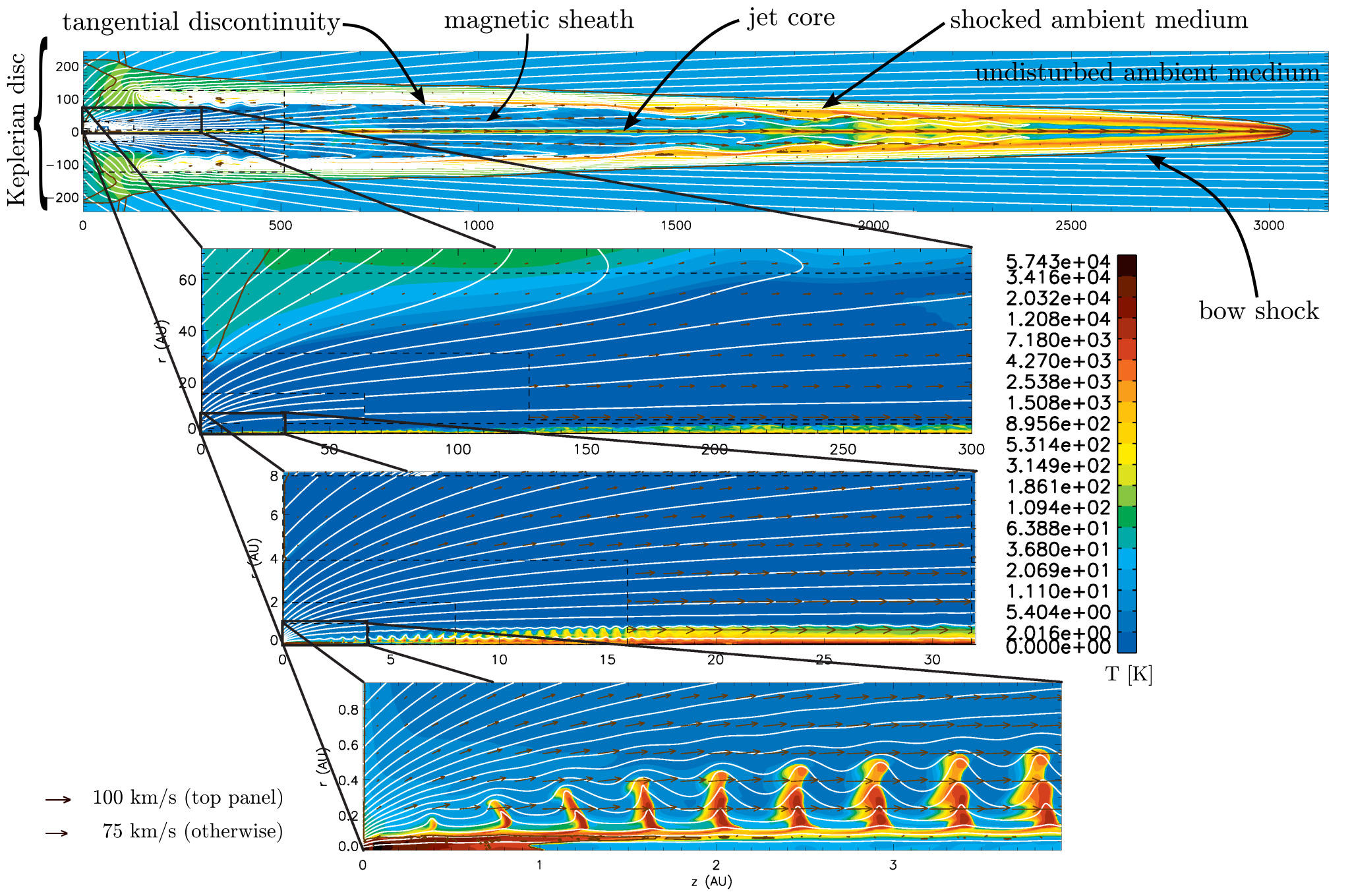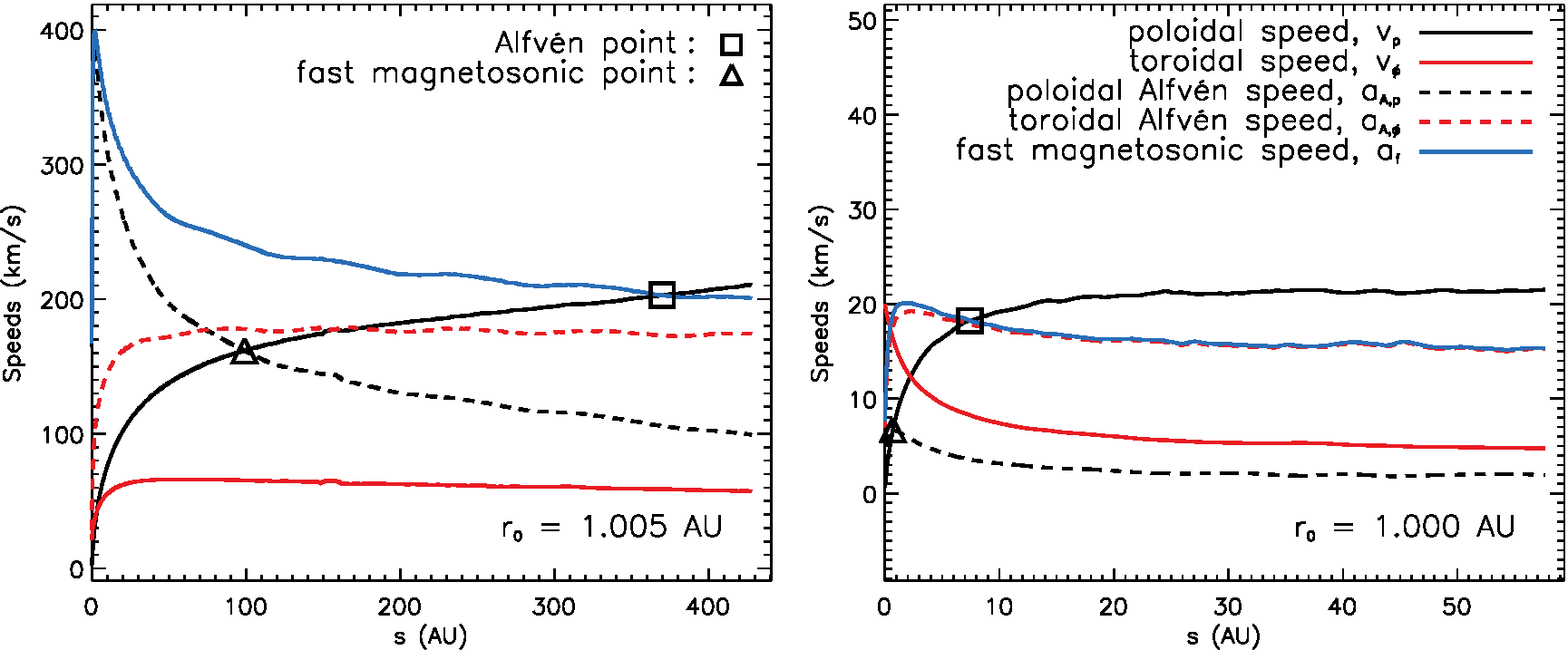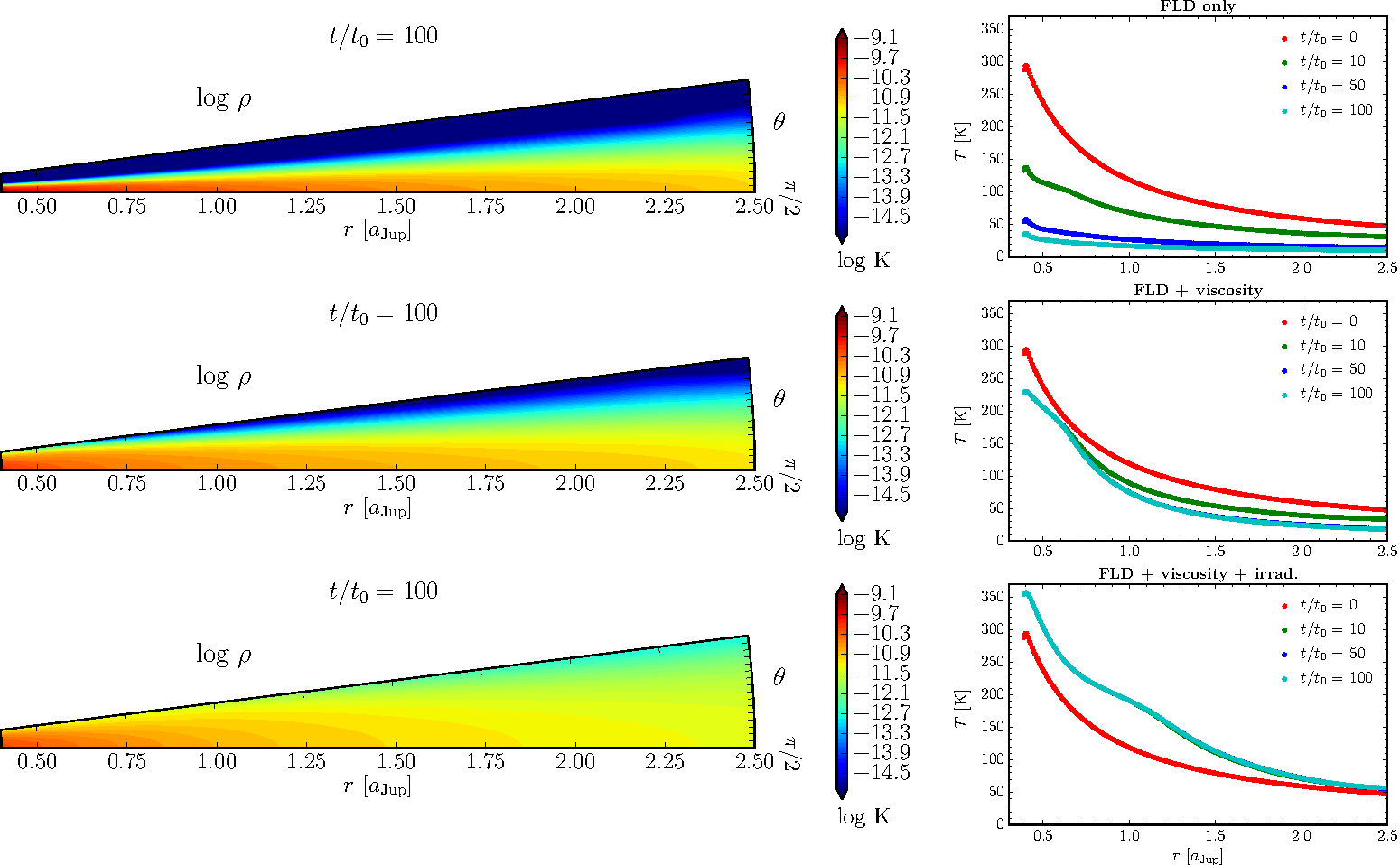Past Research
Magnetically-launched protostellar jets
It is now generally accepted that magnetic fields are responsible for launching and collimating large-scale outflows from discs and young stars. Although there are a substantial number of numerical studies in the literature which examine the launching and collimation of protostellar jets, they generally only resolve the region required to accurately model the jet launching (< 0.1 AU; e.g., Tzeferacos et al. 2013). In contrast, observations (e.g., Schneider et al. 2013) and much larger-scale simulations (e.g., Seifried et al. 2012) have difficulty resolving the launching region [1].
My numerical simulations of protostellar jets (Ramsey & Clarke 2011) were the first to simultaneously resolve the launching region (at < 0.1 AU) and the much larger observational length scales (> 1000 AU). Figure 1 shows a characteristic result for these ideal MHD simulations, illustrating the salient features of the jet. In total, 7 simulations were performed with different initial magnetic field strengths, \(B_i\) (values ranged from 5 G to 200 G, with corresponding values of plasma-\(\beta_i\) between 160 and 0.1.), and run for t = 100 yr, or until the jet left the computational domain. For animations and plots of the other simulations, please visit this webpage and/or read Ramsey & Clarke (2019).

Figure 1: A simulated jet with \(B_i\) = 20 G at t = 100 yr. Temperature is shown in colour, field lines in white, velocity vectors and the slow magnetosonic surface in black.
By varying the initial magnetic field strength, we determined that two physical mechanisms act to launch and accelerate protostellar jets: For very strong fields, the magneto-centrifugal mechanism (Blandford & Payne 1982) dominates the jet acceleration, while, for weak fields, it is gradients in toroidal magnetic pressure [\(\nabla(B_\phi^2)\)] that provide the majority of the acceleration (a “magnetic tower’‘; Lynden-Bell 1996). Figure 2 illustrates this point by using various speeds along a magnetic field line anchored at the disc surface as proxies for the magnetic forces.

Figure 2: Various speeds as a function of s, the position along a field line with foot point \(r_0\), anchored at the disc surface. Left: \(B_i\) = 200 G. Right: \(B_i\) = 5 G.
The ratio between poloidal and toroidal terms of the Lorentz force along a field line can be written as \(F_{L,\parallel}/F_{L,\phi} = -B_\phi/B_p = -a_{A,\phi}/a_{A,p}\) (Zanni et al. 2007). For strong magnetic fields, where \(a_{A,p} > a_{A,\phi}\), the magneto-centrifugal mechanism provides ~80% of the total acceleration (Figure 2, left). Meanwhile, for weak fields, > 60% of the acceleration occurs after the Alfvén point, where \(v_p > v_{A,p}\), \(a_{A,p} < a_{A,\phi}\), and thus gradients in toroidal magnetic pressure provide the majority of the acceleration (Figure 2, right). At intermediate field strengths (not shown), both mechanisms contribute roughly equally to the acceleration of the fluid.
Footnotes
[1] The collapse simulations of Tomida et al. 2013 do resolve the jet launching region, but, due to computational restrictions, only for ~1 yr beyond core formation.
FUV photoevaporation of protoplanetary discs
Observations of discs around young stars show evidence for a “two-timescale” problem with regards to disc lifetimes: Discs slowly accrete onto the star for a few Myr, but then quickly dissipate on time scales of ∼\(10^5\) yr. Currently, the most popular mechanism that can account for these time scales is photoevaporation by stellar radiation.
Photoevaporation of protoplanetary discs breaks down into three regimes, based on the energy of the radiation:
- X-rays: hν > 100eV
- extreme-UV (EUV): 13.6eV < hν < 100eV
- far-UV (FUV): 6eV < hν < 13.6eV
While simulating EUV photoevaporation is relatively straightforward (the temperature of the photoionised gas is nearly constant at ∼\(10^4\) K), modelling FUV and X-ray photoevaporation is significantly more complicated because the disc chemistry must be considered. In addition, while EUV and X-ray photoevaporation by stellar radiation has previously been studied with radiation hydrodynamical simulations (e.g., Alexander, Clarke, & Pringle 2006; Owen, Clarke, & Ercolano 2012), to date, the best models of FUV photoevaporation are those of Gorti, Dullemond, & Hollenbach 2009, which solve the disc chemistry coupled to simple viscous evolution models, and assume the disc to be in hydrostatic equilibrium [2].
To tackle this challenging problem, I have added a radiation module to AZEuS. I adopt the recently popular approach to radiation hydrodynamics in discs where flux-limited diffusion (FLD) is combined with a simple ray-tracing algorithm for the direct stellar irradiation (e.g., Kuiper et al. 2010; Bitsch et al. 2013; Kolb et al. 2013; Flock et al. 2013).
One of the strengths of the simple irradiation algorithm is that (unlike FLD) it can cast shadows. This can be demonstrated using the so-called “shadow test” (e.g., Hayes & Norman 2003; Jiang, Stone, & Davis 2012), where a dense, cold clump of gas is illuminated by an external radiation field. As demonstrated in this animation, increasing the strength of the external radiation source to the point where radiation pressure becomes important results in evaporation of the clump.
A test problem for the code which is more relevant to protoplanetary discs is depicted in Figure 3. Following Kolb et al. 2013, it shows an accretion disc which relaxes from some initial state to equilibrium with hydrodynamics, a (constant) kinematic viscosity, FLD, and stellar irradiation turned on.

Figure 3: An accretion disc modelled with hydrodynamics and FLD only (top), plus kinematic viscosity (\(\nu = 10^{15} \mathrm{cm}^2 \mathrm{s}^{-1}\)) (middle), and plus stellar irradiation (bottom). Left: Contours of gas density. Right: The midplane temperature as a function of radius. \(t_0 = 3.732\times10^8\)s, or one Keplerian period at the semi-major axis of Jupiter.
It is well established that the dust and gas temperature decouple in the upper layers of a protoplanetary disc (e.g., Gorti & Hollenbach, 2008). This effect is important for FUV photoevaporation because the different heating and cooling processes depend on the gas temperature, the dust temperature, or both.
In order to consider this effect, I have recently adopted a multi-fluid approach in AZEuS by treating dust and gas temperatures separately [3]. More specifically, although the gas and dust are assumed to have the same velocities and density distribution (notwithstanding a dust-to-gas ratio of 0.01), the dust is otherwise treated as a pressureless fluid. In the current implementation, only the dust interacts directly with the diffuse radiation field (i.e., FLD) and stellar irradiation. In addition to pressure gradients, the gas experiences the usual compressional heating term, viscous heating, and heating/cooling via a source term. Meanwhile, gas-dust coupling is provided via “thermal accommodation” (Burke & Hollenbach, 1983).
Again, there’s more, but see Ramsey & Dullemond (2015) and Gressel, Ramsey, et al. (2020)
Footnotes
[2] Given that photoevaporation can remove a significant fraction of the disc mass with time, this is not likely a reasonable assumption.
[3] Actually, I’ve resurrected the old “TWOFLUID” option of ZEUS-3D, which was originally implemented in the 90s (by Byung-Il Jun) for use with cosmic ray interaction and diffusion.
AZEuS: AMR + ZEUS
The simulations discussed above were made possible, in part, by the development of AZEuS, an adaptive mesh refinement (AMR) enabled version of the ZEUS-3D MHD fluid code. The development of AZEuS occupied a significant portion of my Ph.D. work. AZEuS uses the grid-based AMR of Berger & Colella (1989), modified for use with the fully staggered mesh of ZEUS [4]. Simulations with AZEuS are possible in 1-, 2-, and 3-D in Cartesian, spherical, and cylindrical coordinates. For details on the algorithms and test problems, please see Ramsey, Clarke, & Men’shchikov (2012) and the AZEuS website.
Footnotes
[4] By fully staggered, I mean both momenta and magnetic fields are face-centred quantities.
